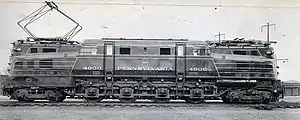Pennsylvania Railroad class R1
The Pennsylvania Railroad's class R1 comprised a single prototype electric locomotive constructed in 1934 by the Baldwin Locomotive Works of Philadelphia, Pennsylvania, USA, with the electrical equipment by Westinghouse.[2]
| PRR R1 | |||||||||||||||||||||||||||||||||||||||||
|---|---|---|---|---|---|---|---|---|---|---|---|---|---|---|---|---|---|---|---|---|---|---|---|---|---|---|---|---|---|---|---|---|---|---|---|---|---|---|---|---|---|
 R1 #4800 in its builders' portrait | |||||||||||||||||||||||||||||||||||||||||
| |||||||||||||||||||||||||||||||||||||||||
| |||||||||||||||||||||||||||||||||||||||||
| |||||||||||||||||||||||||||||||||||||||||
| |||||||||||||||||||||||||||||||||||||||||
It was built as a competitor to the GG1 design, but after trials the GG1 was selected for volume production on the basis of its superior tracking and riding qualities; the R1 prototype, however, remained in service. It was numbered 4800 originally, swapped numbers with the victorious GG1 prototype to #4899, but was moved in May 1940 to #4999 to make room for the expanding GG1 fleet.[3]
For many years, the R1's regular duties involved hauling the westbound Broadway Limited and returning eastward with a mail and express train. The long rigid wheelbase of the locomotive caused occasional derailments in Sunnyside Yard and elsewhere. The R1 was withdrawn from service and sent for scrap in 1958.[3]
The R1 design had four driven axles in a rigid locomotive frame, like a steam locomotive. Each was driven by two 625-horsepower (466 kW) traction motors driving the wheels through a quill drive and sprung cups. Each end of the double-ended locomotive has a four-wheel truck to guide the locomotive at speed, giving the R1 a 4-8-4 wheel arrangement in the Whyte notation (AAR: 2-D-2; UIC: 2'Do'2). Besides the R1, the PRR did not build or order any other 4-8-4 locomotives, however the T1 duplex was essentially a 4-8-4 with 2 sets of driving wheels, making it a 4-4-4-4. In many respects the design resembled the earlier, lighter P5, but with an extra driving axle and lower axle loads.
References
- Pennsylvania Railroad. "PRR R1 Diagram". PRR.Railfan.net. Retrieved 2008-08-27.
- Staufer, Alvin F.; Pennypacker, Bert (1962). Pennsy Power: Steam and Electric Locomotives of the Pennsylvania Railroad, 1900-1957. Research by Martin Flattley. Carollton, Ohio: Alvin F. Staufer. ISBN 978-0-9445-1304-0.
- Barris, Wes. "The Pennsylvania Railroad GG1: The R1". SteamLocomotive.com. Retrieved 2008-08-27.